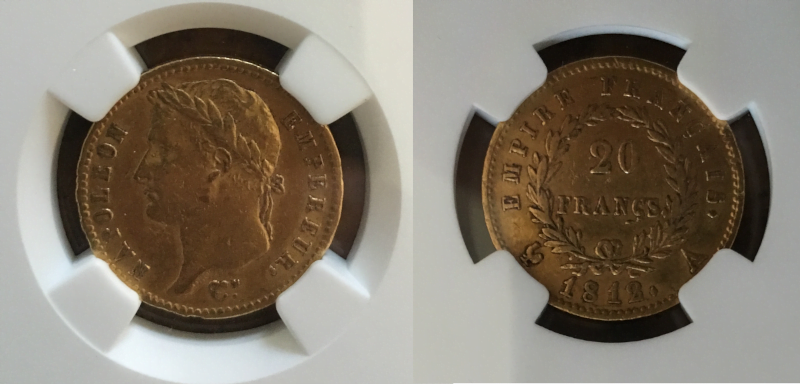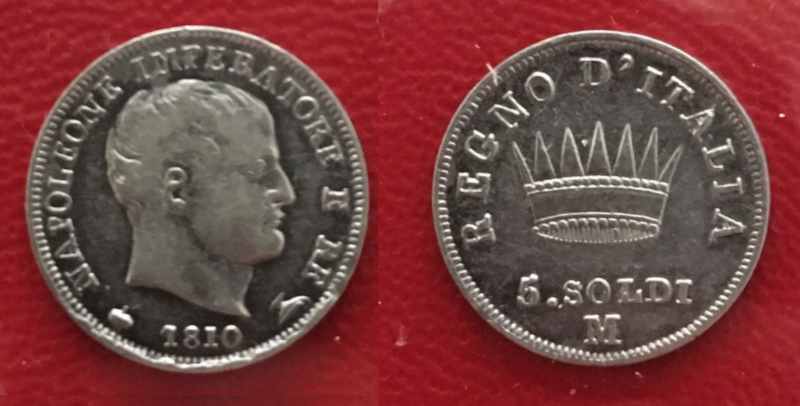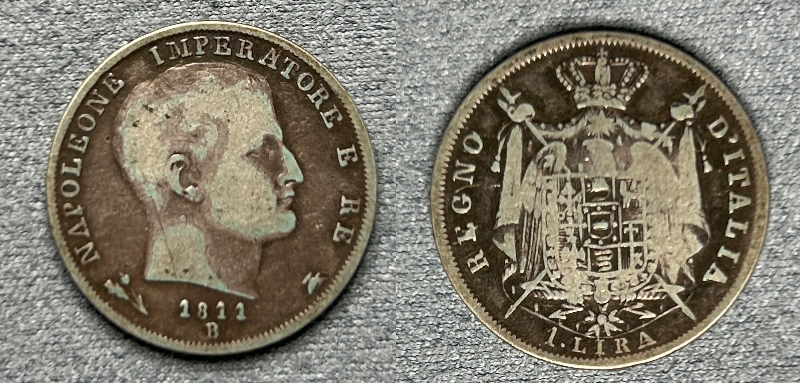Napoleon Bonaparte sure is on a lot of coins and tokens.
That might seem like an obvious statement. After all, if you conquer or subjugate most of Europe, then it’s likely that your face will be on all sorts of things – both in favor of and opposition to you. For a figure as dominating and polarizing as Napoleon, collecting coins, tokens and currency with his likeness on them can be a full-time hobby.
Recently, I acquired a few Napoleonic coins and tokens. I’ll talk about the coins in this post and then the tokens in a future post.
Napoleon Bonaparte was born in 1769 in Corsica to a family of Italian descent. That same year, Corsica, a former territory of Genoa, was invaded by France and soon became a French province.
As a child, Napoleon attended military school in Brienne, France, where as legend has it, he first displayed his tactical nous by devising and executing an innovative and victorious battle plan during the course of a ten-day snowball fight. As historians have pointed out, this one doesn’t really pass the smell test. For one thing, he was a natural Italian speaker who was often ridiculed for his poor command of the French language. Additionally, he came from a modest background and wasn’t well-liked or respected enough to command an army of ants, let alone one made up of his peers and social superiors.
Indeed, under normal circumstances, his lack of social standing would have consigned him to a life of mediocrity and obscurity. However, Napoleon had the good fortune of coming of age during the French Revolution. Political instability, malleable allegiances and military success, in addition to the egalitarian spirit of the Revolution, allowed the Corsican to rapidly rise through the ranks on his own merits.
A series of successful military campaigns resulted in him becoming the most popular person in France and, during this period of instability and bloodshed, Napoleon soon became the leading political figure, as well. A bloodless coup in 1799 led to Napoleon becoming the de facto leader of France. Five years later, he was Emperor Napoleon I — absolute ruler of a country whose language was still his second tongue.

As Emperor, Napoleon completely overhauled France’s monetary policy, issuing a law in 1803 setting the value of 1 franc to 5 grams of silver and 1 kilogram of gold being equal to 15.5 kilograms of silver. The government issued gold 20 and 40 franc coins (bearing Napoleon’s bust on the obverse), as well as silver and copper coins covering smaller denominations.

The above coin is a silver demi (one-half) franc. The reverse of the coin bears “République Française” on it, even though France had ceased being a republic upon Napoleon’s coronation as emperor. Indeed, 1808 was the last year franc coins would bear those words. Starting the following year, all franc coins would be officially issued by the “Empire Français.”
The bust of Napoleon shows him wearing a Greek-style laurel wreath similar to one worn by Roman emperors — reinforcing his connection to Augustus and the other Caesars. Different versions of the emperor wearing a laurel wreath crown adorned many other coins during his reign, including several versions of the famous gold Napoleon.
Indeed, Napoleon was desperate to connect himself to great rulers throughout history, and even named his crown after Charlemagne, the legendary King of the Franks. In addition to giving him the credibility he needed to implement his radical reforms and wage his near non-stop wars, portraying himself as the heir to so many legendary rulers was important to maintaining his popularity with the people (in addition to his continued success on the battlefield). For someone who witnessed the overthrow of the king, the Reign of Terror, the Thermidorian Reaction and the Directory, Napoleon knew all too well how fleeting power could be.



Having conquered most of northern Italy, Napoleon established the Kingdom of Italy as a satellite state. In 1805, he crowned himself King of Italy and set about overhauling its monetary system like he had in France. He created the lira, which served as Italy’s main form of currency until the introduction of the Euro, and as with the franc, set the value of 1 lira to 5 grams of silver. Surprisingly, the busts used for the Italian coins do not include any busts of Napoleon wearing a Roman-style laurel wreath. Instead, a regular bust is used, with either a crown or the Coat of Arms of Napoleonic Italy on the reverse.
Napoleon would rule as King of Italy until 1814, when he abdicated both the Italian and French thrones and went into exile to Elba, whereupon the Kingdom of Italy was broken up and restored into its pre-Napoleonic patchwork of city-states.
The 1 Lira and 5 Soldi coins are made of silver while the 1 Soldo coin is copper. They cost less than some of the Napoleon franc coins I saw online (which is why I have three Italian Napoleonic coins and only one French coin). I’m not sure why that is. Maybe it’s because there’s greater demand in France, where Napoleon has a mixed legacy, but remains an object of fascination. As we’ve seen with China and France during World War II, Italians may be loathe to glorify a former conqueror. Then again, as historian Denis Mack Smith points out, Napoleon’s attempts at uniting part of Italy helped pave the way for the ultimately successful Italian unification in the late 1800s.
But neither the novelty nor the permanence of Napoleon’s contribution should be exaggerated. Some of these reforms had been anticipated in Italy during the eighteenth-century Enlightenment, and the rest, once Napoleon had gone, mostly lapsed. The Kingdom of Italy split up again into its constituent elements and the emperor’s laws were usually repealed. Most Italians were glad to be rid of him, less because he was a “foreigner” than because heavy taxes and conscription were obnoxious, and because they hoped that the milder government of pope or duke would be less interfering and easier to disobey… This notwithstanding, shortly after Napoleon’s final defeat the German scholar Niebuhr could write from Rome that Italy was bound to be united in the course of a generation or two, and Stendhal, for many years a French consul in Italy, noted the same trend. That such a revolution was at last conceivable is to be ascribed in part to Napoleon’s influence, and some of the future leaders of Italian patriotism came from families who became rich under his regime. — Smith, Modern Italy: A Political History.
Stay tuned for Part 2, where I’ll look at some Napoleonic tokens in my collection.

